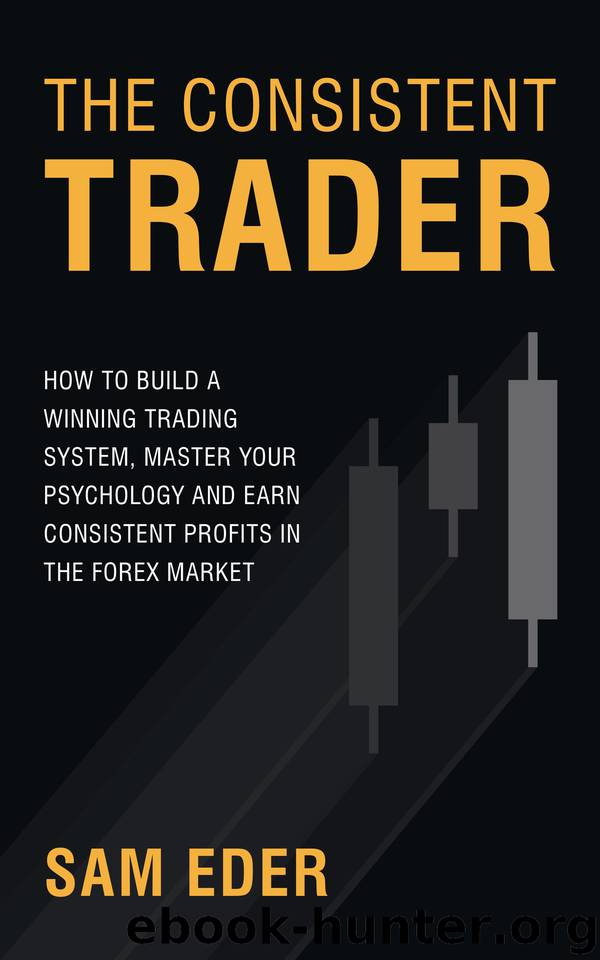The Consistent Trader: How to Build a Winning Trading System, Master Your Psychology, and Earn Consistent Profits in the Forex Market by Eder Sam

Author:Eder, Sam [Eder, Sam]
Language: eng
Format: epub
Publisher: TCK Publishing
Published: 2017-02-10T16:00:00+00:00
An exit rule in case of reversal right after entry
An exit rule for an intra-trade drawdown
An exit rule if the trade moves steadily in your favor and then reverses
An exit rule for a fast-moving market in your favor
An exit rule for a fast-moving market against you
An exit rule for once the price gets close to your profit objective and starts to fall away
An exit rule for chart patterns that signal reversals
An exit rule if fundamental or sentiment conditions change .
Simple Entries Vs. Complex Exits
In chapter 10, we learned that your actual rule for getting into the trade should be simple. Complexity is the enemy of decisiveness. Why, then, am I saying you should have a complex exit strategy?
Each component of your exit strategy on its own is quite simple, yet when combined, they form a complex exit strategy. Contrary to the popular wisdom that a simple trading plan is better, exits need to be able to cater to many different circumstances. Ideally, you want to have a set of clear rules that will allow you to manage risk and protect your profits, depending on what the market does.
The Market Is Going to Force You to Make Decisions
Throughout your trade, the market is going to throw you all sorts of different scenarios. It is going to force you to make decisions about what to do constantly. Often, it will be best to sit tight and do nothing, but there will be times when you should take action. At each of these “decision points”, your complex exit strategy comes into play.
You will need to assess the current market, and apply the right tool for the job to manage your trade properly. A decision point could arise because of market action, or it could arise because a pre-planned price was hit. A reversal pattern could form, or the price could reverse a number of R-multiples, and you need to decide if you are going to stay in the trade, or if it’s time to exit or reduce your position size. Be aware that these decision points are going to happen, and be ready to act when they do. Trading what’s in front of you is all about being prepared .
Learn to Expect What Comes Next, and Play the Probabilities
“Your job is to follow the system. If the system does something that results in losses. That’s just an expected part of the system. Your Judgement might be on the line over the performance of the entire system, but there is no sense in which your judgement is on the line on any single trade.”
~ William Eckhardt
In developing your complex exit strategy, it is important to understand market types. If you know what market type the currency pair is in, then you can predict what might follow. For example, a bull normal market will often transition to a bull volatile and then a volatile sideways phase before falling into a bear market. If you know this is the probable outcome, you can plan your exits accordingly.
Download
This site does not store any files on its server. We only index and link to content provided by other sites. Please contact the content providers to delete copyright contents if any and email us, we'll remove relevant links or contents immediately.
| Corporate Finance | Crowdfunding |
| Financial Engineering | Financial Risk Management |
| Wealth Management |
The Black Swan by Nassim Nicholas Taleb(6940)
Bad Blood by John Carreyrou(6470)
Pioneering Portfolio Management by David F. Swensen(6166)
Millionaire: The Philanderer, Gambler, and Duelist Who Invented Modern Finance by Janet Gleeson(4286)
Skin in the Game by Nassim Nicholas Taleb(4120)
The Money Culture by Michael Lewis(4019)
Bullshit Jobs by David Graeber(3985)
Skin in the Game: Hidden Asymmetries in Daily Life by Nassim Nicholas Taleb(3865)
The Wisdom of Finance by Mihir Desai(3601)
Blockchain Basics by Daniel Drescher(3426)
Liar's Poker by Michael Lewis(3316)
Fooled by Randomness: The Hidden Role of Chance in Life and in the Markets by Nassim Nicholas Taleb(2968)
The Intelligent Investor by Benjamin Graham Jason Zweig(2963)
Hands-On Machine Learning for Algorithmic Trading by Stefan Jansen(2962)
Mastering Bitcoin: Programming the Open Blockchain by Andreas M. Antonopoulos(2946)
Investing For Dummies by Eric Tyson(2828)
The Power of Broke by Daymond John(2826)
Market Wizards by Jack D. Schwager(2586)
Zero Hour by Harry S. Dent Jr. & Andrew Pancholi(2561)
